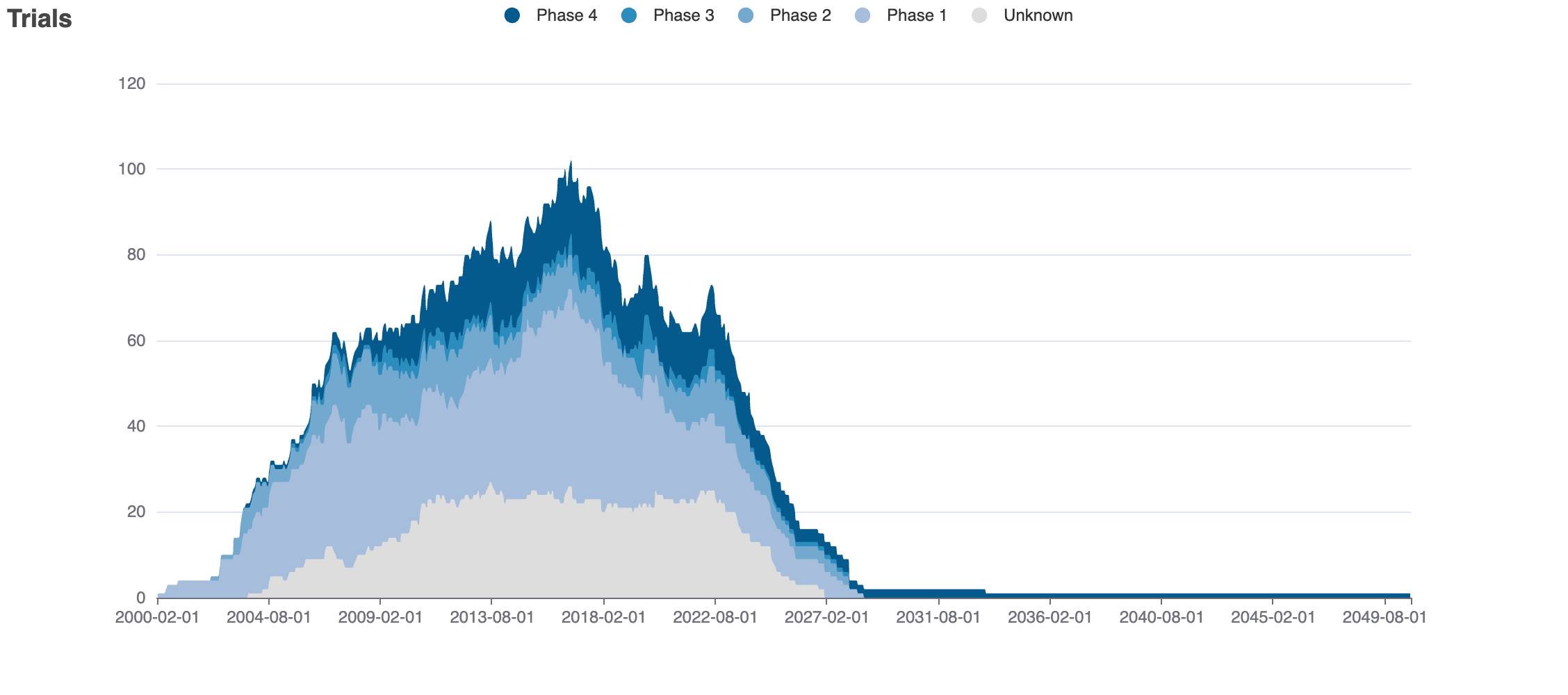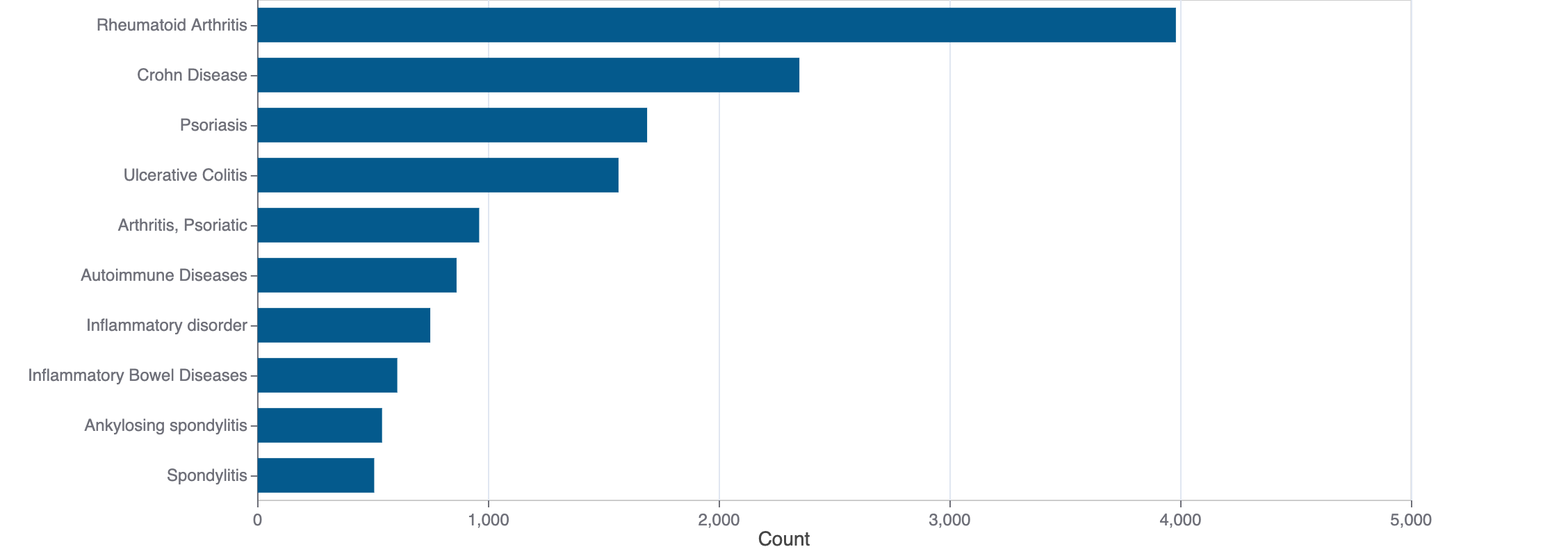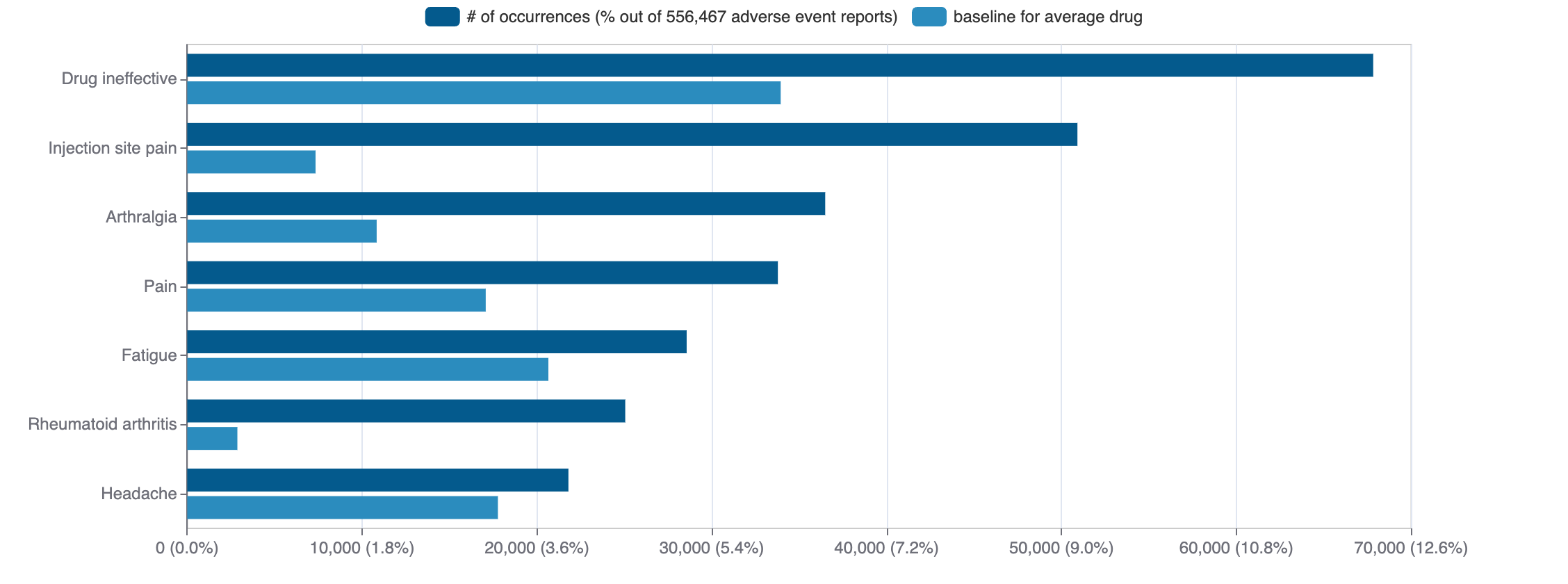Tranexamic acid
Cyklokapron, Lysteda (tranexamic acid) is a small molecule pharmaceutical. Tranexamic acid was first approved as Cyklokapron on 1986-12-30. It is used to treat inherited blood coagulation disorders and subarachnoid hemorrhage in the USA. The pharmaceutical is active against plasminogen.
Download report
Favorite
Commercial
Trade Name
FDA
EMA
Cyklokapron, Lysteda (generic drugs available since 2011-08-10)
Drug Products
FDA
EMA
New Drug Application (NDA)
New Drug Application (NDA)
Abbreviated New Drug Application (ANDA)
Abbreviated New Drug Application (ANDA)
Labels
FDA
EMA
Brand Name | Status | Last Update |
|---|---|---|
| cyklokapron | New Drug Application | 2021-04-02 |
| lysteda | New Drug Application | 2020-12-31 |
| tranexamic acid | ANDA | 2023-05-19 |
Indications
FDA
EMA
Indication | Ontology | MeSH | ICD-10 |
|---|---|---|---|
| inherited blood coagulation disorders | — | D025861 | — |
| subarachnoid hemorrhage | EFO_0000713 | D013345 | I60 |
Agency Specific
FDA
EMA
No data
HCPCS
No data
Clinical
Clinical Trials
531 clinical trials
View more details

Mock data
Subscribe for the real data
Subscribe for the real data
Indications Phases 4
Indication | MeSH | Ontology | ICD-10 | Ph 1 | Ph 2 | Ph 3 | Ph 4 | Other | Total |
|---|---|---|---|---|---|---|---|---|---|
| Hemorrhage | D006470 | MP_0001914 | R58 | 2 | 11 | 14 | 22 | 12 | 57 |
| Surgical blood loss | D016063 | 3 | 5 | 9 | 13 | 2 | 29 | ||
| Postpartum hemorrhage | D006473 | O72 | 2 | 6 | 11 | 7 | 4 | 27 | |
| Hip fractures | D006620 | EFO_0003964 | S72.00 | 1 | 2 | 6 | 8 | 4 | 21 |
| Knee osteoarthritis | D020370 | EFO_0004616 | M17 | — | 3 | 1 | 8 | 4 | 16 |
| Osteoarthritis | D010003 | EFO_0002506 | M15-M19 | 1 | 4 | 3 | 4 | 5 | 16 |
| Postoperative hemorrhage | D019106 | 1 | 4 | 2 | 5 | 2 | 12 | ||
| Menorrhagia | D008595 | N92.0 | 1 | 1 | 5 | 4 | 2 | 12 | |
| Melanosis | D008548 | EFO_0003963 | L81.1 | 1 | 1 | 3 | 2 | 4 | 10 |
| Anemia | D000740 | EFO_0004272 | D64.9 | 1 | 1 | 2 | 4 | 2 | 10 |
Show 89 more
Indications Phases 3
Indication | MeSH | Ontology | ICD-10 | Ph 1 | Ph 2 | Ph 3 | Ph 4 | Other | Total |
|---|---|---|---|---|---|---|---|---|---|
| Cerebral hemorrhage | D002543 | 1 | 4 | 2 | — | — | 6 | ||
| Von willebrand diseases | D014842 | D68.0 | — | — | 2 | — | 3 | 5 | |
| Subdural hematoma chronic | D020200 | — | 3 | 4 | — | — | 5 | ||
| Hemoptysis | D006469 | HP_0002105 | R04.2 | — | — | 4 | — | 1 | 5 |
| Traumatic brain injuries | D000070642 | S06 | — | 1 | 4 | — | — | 5 | |
| Neoplasms | D009369 | C80 | — | — | 4 | — | 1 | 5 | |
| Covid-19 | D000086382 | U07.1 | — | 3 | 1 | — | — | 4 | |
| Hematologic neoplasms | D019337 | — | 1 | 3 | — | — | 4 | ||
| Ileus | D045823 | K56.7 | 1 | 2 | 1 | — | — | 4 | |
| Hereditary hemorrhagic telangiectasia | D013683 | I78.0 | — | 1 | 2 | — | — | 3 |
Show 39 more
Indications Phases 2
Indication | MeSH | Ontology | ICD-10 | Ph 1 | Ph 2 | Ph 3 | Ph 4 | Other | Total |
|---|---|---|---|---|---|---|---|---|---|
| High-risk pregnancy | D018566 | — | 1 | — | — | 1 | 2 | ||
| Shock | D012769 | R57.1 | — | 2 | — | — | — | 2 | |
| Pneumonia | D011014 | EFO_0003106 | J18 | — | 1 | — | — | — | 1 |
| Operative surgical procedures | D013514 | — | 1 | — | — | — | 1 | ||
| Urinary retention | D016055 | HP_0000016 | R33 | 1 | 1 | — | — | — | 1 |
| Prostatic neoplasms | D011471 | C61 | 1 | 1 | — | — | — | 1 | |
| Hematuria | D006417 | HP_0000790 | R31 | 1 | 1 | — | — | — | 1 |
| Patient satisfaction | D017060 | 1 | 1 | — | — | — | 1 | ||
| Nurse's role | D024802 | 1 | 1 | — | — | — | 1 | ||
| Physician-nurse relations | D019555 | 1 | 1 | — | — | — | 1 |
Show 9 more
Indications Phases 1
Indication | MeSH | Ontology | ICD-10 | Ph 1 | Ph 2 | Ph 3 | Ph 4 | Other | Total |
|---|---|---|---|---|---|---|---|---|---|
| Healthy volunteers/patients | — | 2 | — | — | — | — | 2 | ||
| Skin neoplasms | D012878 | EFO_0004198 | C44 | 1 | — | — | — | 1 | 2 |
| Back pain | D001416 | HP_0003418 | M54 | 1 | — | — | — | — | 1 |
| Knee prosthesis | D007720 | 1 | — | — | — | — | 1 | ||
| Hip osteoarthritis | D015207 | EFO_1000786 | M16 | 1 | — | — | — | — | 1 |
Indications Without Phase
Indication | MeSH | Ontology | ICD-10 | Ph 1 | Ph 2 | Ph 3 | Ph 4 | Other | Total |
|---|---|---|---|---|---|---|---|---|---|
| Hemostasis | D006487 | — | — | — | — | 3 | 3 | ||
| Hemophilia a | D006467 | EFO_0007267 | D66 | — | — | — | — | 2 | 2 |
| Musculoskeletal diseases | D009140 | — | — | — | — | 1 | 1 | ||
| Mortality | D009026 | EFO_0004352 | — | — | — | — | 1 | 1 | |
| Myoma | D009214 | D21 | — | — | — | — | 1 | 1 | |
| Nerve block | D009407 | — | — | — | — | 1 | 1 | ||
| Cytoreduction surgical procedures | D065426 | — | — | — | — | 1 | 1 | ||
| Congenital hip dislocation | D006618 | HP_0001385 | Q65.2 | — | — | — | — | 1 | 1 |
| Femur head necrosis | D005271 | — | — | — | — | 1 | 1 | ||
| Aortic dissection | D000784 | I71.0 | — | — | — | — | 1 | 1 |
Show 13 more
Epidemiology
Epidemiological information for investigational and approved indications
View more details
Drug
General
| Drug common name | TRANEXAMIC ACID |
| INN | tranexamic acid |
| Description | Tranexamic acid is a monocarboxylic acid. It has a role as an antifibrinolytic drug and a hematologic agent. It is functionally related to a cyclohexanecarboxylic acid. |
| Classification | Small molecule |
| Drug class | — |
| Image (chem structure or protein) | |
| Structure (InChI/SMILES or Protein Sequence) | NC[C@H]1CC[C@H](C(=O)O)CC1 |
Identifiers
| PDB | — |
| CAS-ID | 1197-18-8 |
| RxCUI | 10691 |
| ChEMBL ID | CHEMBL877 |
| ChEBI ID | 48669 |
| PubChem CID | 5526 |
| DrugBank | DB00302 |
| UNII ID | 6T84R30KC1 (ChemIDplus, GSRS) |
Target
Variants
Clinical Variant
No data
Financial
No data
Trends
PubMed Central
Top Terms for Disease or Syndrome:

Mock data
Subscribe for the real data
Subscribe for the real data
Additional graphs summarizing 11,255 documents
View more details
Safety
Black-box Warning
No Black-box warning
Adverse Events
Top Adverse Reactions

Mock data
Subscribe for the real data
Subscribe for the real data
587 adverse events reported
View more details
Premium feature
Learn more about premium features at pharmakb.com
Learn more
